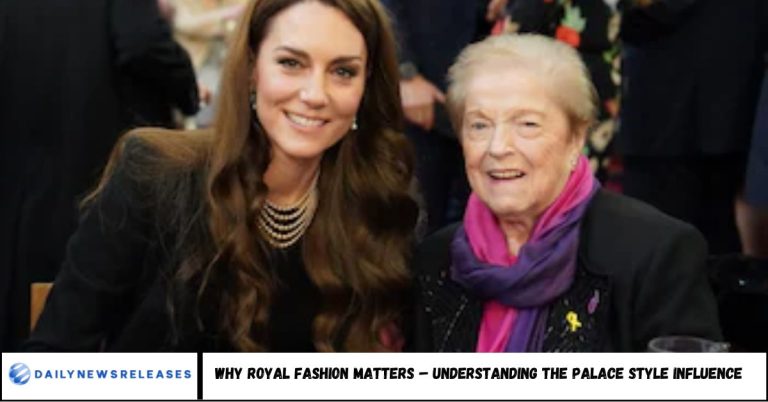Why does covering royal fashion matter? Because it’s more than style royal attire shapes culture, commerce and identity. This article examines why writing about royal style is important, explores the influence of modern monarchs on fashion trends, commerce and sustainability, and offers clear insights into the power of style as communication.
What happens when the wardrobes of royals become headline news rather than side notes? At first glance, focusing on what a royal wears might seem trivial. But is it really? Covering royal fashion opens windows into cultural influence, economic impact and social identity. In this article we’ll ask why writing about royal fashion matters, trace how royal style drives global trends, business and sustainability, and show how journalists and commentators can bring these threads into focus with meaningful coverage.
The Princess’s style often illuminates the causes she champions, but the Palace’s latest move can’t stop the world from talking about her wardrobe.
It’s easy to understand why the Princess of Wales might want the focus to shift from what she wears to the work she does. Fourteen years into her role with “The Firm,” many of the two dozen charities she supports have become deeply personal to her. Yet even a simple accessory can draw more scrutiny than the substantial initiatives she’s spearheaded, such as her work with The Centre for Early Childhood Learning. After a year full of challenges and milestones, she’s likely gained fresh perspectives on her role and how she wants to navigate it moving forward.
1. The Basic Case: Royal Fashion Is More Than Clothes
- Symbolic communication: Royal garments often signal values—heritage, national identity, or social change.
- Trend leadership: When a royal wears a piece, it frequently triggers wider public interest and commerce.
- Media engagement: Fashion‑stories about royals generate high search and social engagement. For example, “royal dress” search volume peaked in March 2025.
Starting from these basics, it becomes clear that covering royal fashion is not just gossip—it’s a lens on broader cultural dynamics.
2. The Cultural & Economic Impact of Royal Style
Cultural
Royal fashion plays a role in shaping public perceptions of identity and values. For instance:
- Royals wear designs from local artisans, promoting cultural heritage.
- Their choices often reflect social commitments—such as reuse of outfits, sustainability and ethical fashion.
Economic
- A single appearance by a prominent royal can spray‑paint consumer demand across the market (the so‑called “Kate Effect”).
- The global apparel market was about US$1.53 trillion in 2022, with fashion engagement shifting rapidly as of 2025.
Insight: Writing about royal fashion brings together culture + commerce: it matters to fashion editors and economic watchers alike.
3. Why the Palace Might Prefer You Not Cover It – And Why You Should
The institutional mindset of a palace or royal household may view fashion coverage as superficial or distracting from “real” issues. But this is precisely why it’s worth covering:
- Because attire is a subtle, powerful form of communication, often unacknowledged.
- Because fashion choices can reveal underlying strategy—diplomatic, cultural, or commercial.
- Because neglecting the topic means missing an angle where public interest meets soft power.
Solution for commentators: Cover royal fashion with depth. Ask: What message is being sent? Which values are being signalled? Which industries are affected?
4. Advanced Insight: From Style to Strategic Influence
Sustainability & ethics
Modern royal wardrobes increasingly incorporate sustainability: outfit repeating, ethical brands, local production.
Take‑away: Coverage of royal fashion intersects with coverage of sustainability and ethical consumerism.
Media and commerce interplay
Royal style triggers social commerce and high‑street responses. For example, search spikes show direct interest in “royal dress”.
Take‑away: Royal fashion coverage is part of the media‑market ecosystem.
Identity, diplomacy and symbolism
Attire on state visits, ceremonial occasions or public appearances can carry diplomatic weight.
Take‑away: The clothes tell a story: nation‑brand, continuity, soft power.
5. How to Write About Royal Fashion with Purpose
- Focus on messaging, not just aesthetics: Ask what the outfit means.
- Embed context: Mention fashion impact and cultural significance—not just “what she wore”.
- Use data and trends: e.g., search volume spikes, economic effects.
- Be sceptical and analytical: Who designed the piece? Was it re‑worn? Why that choice now?
- Link to bigger themes: sustainability, commerce, identity, diplomacy.
- Engage reader interest: Use headings, bold points, and questions; vary sentence length; keep voice active.
FAQ
1. Is writing about royal fashion just superficial?
No. When done well, it connects to culture, commerce and broader social themes.
2. Does royal attire really influence fashion trends?
Yes. Search data and media stories show spikes and trickle‑down effects from royal appearances.
3. Can officials discourage fashion coverage?
Yes — but that doesn’t reduce its influence. In fact, it may make coverage more necessary to unpack underlying messages.
4. How should one cover royal fashion to add value?
By analysing context, impact and meaning rather than simply listing outfits.
5. What topics intersect with royal fashion coverage?
Sustainability, national identity, local industry support, media commerce.
6. How can readers benefit from reading about royal fashion?
They gain insight into how public figures use style, how markets respond, and how culture is shaped visually and socially.
Conclusion
Writing about royal fashion is far from frivolous. It’s a meaningful way into how style conveys message, shapes markets and reflects identity. When a palace may wish you to ignore it, that’s exactly the reason to pay attention—to decode the signals. By covering royal attire with purpose and context, you serve readers with insight into the threads that weave fashion, diplomacy, culture and commerce together.

